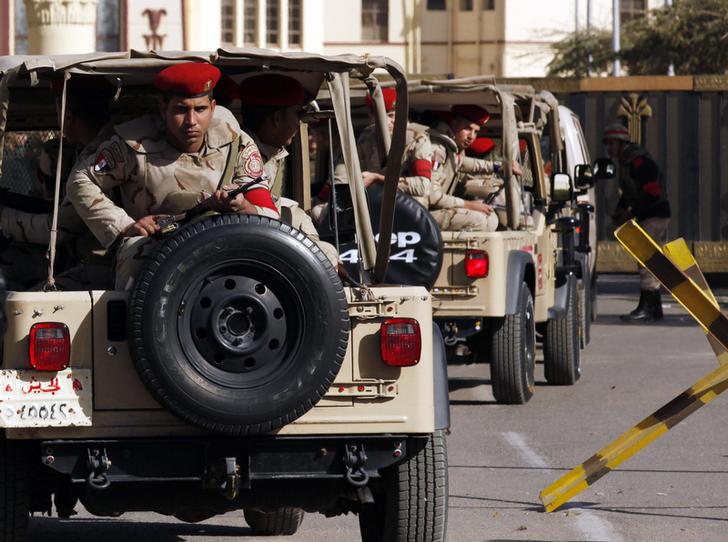Archive Photo. Credit: Asmaa Waguih/ Reuters
Egypt is struggling with a growing problem of armed militancy in the northern region of the Sinai Peninsula. In the last few years, the government has so far largely focused its attempts to tackle this issue with a narrow view of security that gives prominence to solutions based on conventional violent counter-terrorism tactics. This has not remedied the problem or lessened the security threats. Instead, it has contributed to the strengthening of violent actors operating in the area.
The only long-term solution is for the Egyptian government to adopt a broadened view of security that takes into account the root causes of armed militancy instead of only treating what are arguably just symptoms of larger problems. Based on that, the government should apply a comprehensive strategy focusing on economic development, the inclusion of Bedouin inhabitants into political and societal structures and ending the repressive policies – especially collective punishment measures against civilians – that only serve to alienate the historically marginalized North Sinai population.
EMERGENCE OF AN INSURGENCY AND THE GOVERNMENT’S RESPONSE
The fall of President Hosni Mubarak from power in February 2011 destabilized his regime and temporarily weakened the state security apparatus that had underpinned it. This created a security vacuum that quickly was filled by local irregular actors in the Sinai. Since then – and particularly after the ouster of the Muslim Brotherhood’s President Mohamed Morsi in July 2013 – North Sinai’s internal stability has further eroded and sporadic attacks by militants have escalated into a low-level insurgency.
Reflective of the volatile situation is the fact that 47 percent of all reported violent attacks and 69 percent of all deaths between 2011 and 2015 nationwide occurred in North Sinai, according to a recent report by the Tahrir Institute for Middle East Policy (TIMEP). Also, between July 2013 and July 2015 more than 3,600 people were killed in North Sinai, Human Rights Watch asserted in a report from last year.
Although several groups have appeared since 2011, such as al-Qaeda-affiliated al-Murabitun and Jund al-Islam, the group that has risen to most prominence is the Salafist Ansar Beit al-Maqdis (ABM). In November 2014 the group ended its tacit relationship with al-Qaeda by pledging allegiance to Abu Bakr al-Baghdadi and his self-styled Islamic State (IS) and rebranded itself as Wilayat Sinai, or the Sinai Province.
From its emergence in 2011 to September 2013 ABM focused its efforts on sporadically launching attacks against Israel and the gas pipeline transporting fuel from the North Sinai coastal town of al-Arish to Jordan. After that, it turned its attention to Egyptian security forces and, beginning in the month prior to its official merge with IS, it heavily escalated its attacks and grew more sophisticated as an organization. Using everything from machine guns and IEDs to rocket-propelled grenades and car bombs, the group has claimed responsibility for hundreds of deadly attacks on security forces and army personnel, in addition to assassinations of judges as well as downing a Russian passenger plane killing 224 people in October last year.
In parallel, the Egyptian government has responded to this increasingly dangerous insurgency by applying the only tool it seems to know when it comes to domestic opposition – brute force. From the August 2011 military campaign dubbed Operation Eagle to the current one by the name of Martyr’s Right, Egypt has sought to violently crush the insurgency in what it now calls a “war on terror.” Employing army tanks, F16 fighter jets and Apache helicopters, in addition to arbitrarily arresting local journalists, human rights activists and suspected terrorists who often turn out to be ordinary civilians – the central government is carrying out a brutally sweeping crackdown on everything it perceives as a security threat.
Perhaps the most widely reported tactic reaching international audiences was the construction of what Egypt called a “buffer zone” between the Sinai Peninsula and the Hamas-controlled Gaza strip designed to stem the alleged flow of weapons and militants through smuggling tunnels between the two territories. In the border town of Rafah, Egypt – to make way for the buffer zone – authorities demolished around 3,300 homes and other buildings, forcefully evicted tens of thousands of residents and destroyed for the local population crucially important agricultural land. As local residents rely on the smuggling trade and agriculture for their subsistence due to the lack of other economic opportunities, the buffer zone has devastated the North Sinai population.
DISAFFECTION, RADICALIZATION, AND RECRUITMENT
The Egyptian government claims to have killed more than 3,000 “terrorists” during 2015 but has not allowed any independent observers into the fighting zone and has not acknowledged any civilian deaths. One exception is the widely reported, apparently accidental, attack on a bus carrying Mexican tourists, killing 12 civilians.
But although the Egyptian military classifies most of those killed as militants, Sinai residents say that many have been civilians. One Rafah resident told Vice News: “The army’s operations are the reason for the escalation. Most of the people who have joined armed groups do so for revenge.”
Furthermore, in a report from last year, TIMEP concluded: “When smuggling wealth disappeared, not only did this younger generation feel greater antagonism toward the state, but also a greater disregard for tribal leaders who appeared impotent in advocating for the community … Rather than sit back and do nothing, some young Sinai residents have seen the opportunity to fight back, protect their land, and finally bring justice to their community as compelling. Left without any other economic or social opportunity, others simply see no other option than to at least turn a blind eye to militants’ recruitment efforts.”
This helps explain why the insurgency is still ongoing despite the government’s repeatedly violent crackdowns. In the short term, counter-insurgency campaigns may be effective to temporarily subdue violent groups. But since the local residents are the ones who suffer the most from them, they only provide incentives for unemployed and disaffected youth susceptive to radicalization to join these groups.
EXCLUSION AND UNDERDEVELOPMENT
Although the Sinai insurgency has undergone an escalatory transformation in the last few years, the Peninsula has for decades experienced periods of unrest and sporadic upsurges in violence. Located in the eastern periphery of Egypt’s mainland, North Sinai has largely been viewed by successive Egyptian governments as a military zone from which wars could be waged against Israel.
Partly a consequence of this, the mainly Bedouin population residing there has become culturally, socially, economically and politically isolated. The population has been looked upon with suspicion by successive Egyptian governments – a view dating back to the 1967-82 Israeli occupation of the Peninsula when the social and economic conditions improved for the Bedouins who lived peacefully side by side with Jewish settlers.
Since then, Egypt has pursued a policy of land reclamation, expropriating Bedouin ancestral land and giving it to mainland Egyptians. Bedouins have furthermore been excluded from serving in the army and police as well as in tourism and energy development projects and other government jobs. Investments have largely been directed to the southern parts of the Peninsula where lavish tourist resorts have popped up – particularly in Sharm el-Sheikh – where only mainland Egyptians have been allowed to work.
Meanwhile, the North has been starved of investment and left economically underdeveloped. According to a 2013 Social Fund for Development study, poverty afflicts over 45 percent of North Sinai inhabitants. The residents have also been denied basic services such as adequate healthcare, education and even running water and property registration. Although there has been much talk about large-scale development projects – especially since the planning document entitled “The National Project for the Development of the Sinai” was released in 1995 – unfortunately, very little has materialized.
WHAT CAN BE DONE
Although it is important to acknowledge the impact transnational extremist networks may have on the ideological radicalization of local inhabitants, it is difficult to imagine that people would find these ideas appealing if they were included in political, economic, social and cultural structures.
In view of that, the Egyptian government can make efforts to:
1. End repression of the civilian population, particularly collective punishment measures;
2. Embark on meaningful economic development projects;
3. Provide employment opportunities for the Bedouin, especially the youth;
4. Facilitate open political dialogue with the local population, perhaps creating forums where government and community representatives can meet;
5. Deepen cooperation with local Bedouin tribes for intelligence gathering and, if needed, provide arms to them which they can use against IS (the powerful Tarabin tribe has expressed enthusiasm about this);
6. Reduce polarization between the state and the local community by eliminating negative stereotypes of the Bedouin among Egyptians writ large through public awareness campaigns;
7. Mobilize and educate progressive Islamic preachers to counter the narratives of the ideologies of extremist groups; and
8. Revise the ”terrorism entities law” and “anti-terror law” to narrow the definition of terrorism, which does not include peaceful opposition to the government and to allow journalists to independently investigate suspected terrorist attacks.
By expanding the concept of security from only focusing on conventional scorched earth tactics to shifting the attention to economic development, social dialogue, and other non-repressive measures, Egypt can construct a more comprehensive strategy in its efforts to come to grips with its growing problem of militancy in North Sinai.






Comments (8)
[…] article was originally published by Egyptian Streets and is available by clicking here. The views expressed in this article do not necessarily reflect the views of […]
[…] article was originally published by Egyptian Streets and is available by clicking here. The views expressed in this article do not necessarily reflect the views of […]